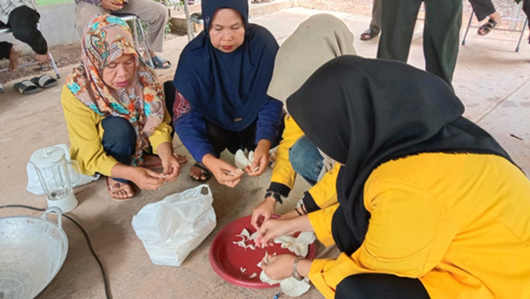Pelatihan Pembuatan Penyedap Rasa Non-MSG Berbahan Dasar Jamur Tiram Putih di Kelurahan Karang Taruna, Kecamatan Pelaihari, Kabupaten Tanah Laut, Kalimantan Selatan Training on Making non-MSG Flavoring Made from White Oyster Mushrooms in Karang Taruna Village, Pelaihari District, Tanah Laut Regency, South Kalimantan
Main Article Content
Abstract
Karang Taruna Village has a group of oyster mushroom farmers where, under certain conditions, the productivity of oyster mushrooms that are too high can cause difficulties. The rainy season with high humidity will increase oyster mushroom growth, so harvests often occur. In addition, if the baglog used is new or when it enters the early harvest stage, the yield will usually peak. Judging from the problems of related partners, which can be seen in the condition of the oyster mushrooms' durability, which is susceptible to damage, it is necessary to diversify the processing of oyster mushrooms. An example of processed oyster mushroom products is non-MSG flavoring, which can be seen in the condition of the people of South Kalimantan, who have switched to using non-MSG seasoning because they are aware of healthy living but still want their food to have added flavoring. The fear that still haunts the public with the COVID-19 outbreak has made people now look for many products, both food and beverages, that can increase immunity as well as products that can prevent various kinds of diseases that will attack and the level of people's dependence on flavoring products. In this condition, the products offered to related partners are expected to become superior products in great demand and promise a large market segment so that, in the future, the family economic sector can improve.
Downloads
Article Details

This work is licensed under a Creative Commons Attribution-ShareAlike 4.0 International License.
Authors who publish with this journal agree to the following terms:
- Any article on the copyright is retained by the author(s).
- Author grant the journal, right of first publication with the work simultaneously licensed under a Creative Commons Attribution License that allows others to share work with acknowledgment of the work authors and initial publications in this journal.
- Authors are able to enter into a separate, additional contractual arrangements for non-exclusive distribution of published articles of work (eg, post-institutional repository) or publish it in a book, with acknowledgment of its initial publication in this journal.
- Authors are permitted and encouraged to post their work online (e.g., in institutional repositories or on their websites) prior to and during the submission process, as can lead to productive exchanges, as well as earlier and greater citation of published work.
- The article and any associated published material is distributed under the Creative Commons Attribution-ShareAlike 4.0 International License
References
Bhattacharya, T, Bhakta, A & Gosh, SK. (2011). Long Term Effect of Monosodium Glutamate in Liver of Albino Mice after Neo-Natal Exposure. Nepal Med Coll J 11.13:1
BPS Statistics of Tanah Laut Regency, Tanah Laut Regency in Figures. (2023). Diakses dari https://tanahlautkab.bps.go.id .
Hidayah, N. (2019). Kualitas penyedap rasa alternatif kombinasi jamur tiram (Pleurotus ostreatus) dan jamur kuping (Auricularia polytricha) dengan variasi suhu dan lama pengeringan. Universitas Muhammadiyah Surakarta Repository. http://eprints.ums.ac.id/id/eprint/74556
Kadaryati, S., & Afriani, Y. (2022). Evaluasi sensori, kandungan gula dan natrium pada formula bumbu penyedap berbasis jamur tiram (Pleurotus ostreatus). Ilmu Gizi Indonesia, 5(2), 163-170. https://doi.org/10.35842/ilgi.v5i2.323
Mahfiroh, V. (2021). Pendirian Unit Bisnis Kaldu Jamur Tiram pada Agro Jamur Pabuwaran Kabupaten Banyumas. Institut Pertanian Bogor Repository. https://ereport.ipb.ac.id/id/eprint/6120
Muchtadi, D. (2010). Teknik Evaluasi Nilai Gizi Protein. Penerbit Alfabeta, Bandung
Ningsih, I. Y., Suryaningsih, I. B., & Rachmawati, E. (2018). Pengembangan Produk Penyedap Rasa dan Tepung Jamur Tiram di Desa Penambangan dan Kelurahan Dabasah Kabupaten Bondowoso. Warta Pengabdian, 12(3), 307-313. https://doi.org/10.19184/wrtp.v12i3.8632
Nugroho, D. (2019). Kualitas Penyedap Rasa Alternatif Kombinasi Jamur Merang (Volvariella volvaceae) Dan Jamur Kuping (Auricularia polytrica) Dengan Variasi Suhu Dan Lama Pengeringan. Universitas Muhammadiyah Surakarta Repository. http://eprints.ums.ac.id/id/eprint/74557
Pagarra, H., Hartati, Muhammad Ilham Wardhana, & Sahribulan. (2022). Olahan Bumbu Bubuk Kaldu Jamur Tiram Di Desa Sokkolia Kecamatan Bontomarannu Kabupaten Gowa. Sasambo: Jurnal Abdimas (Journal of Community Service), 4(4), 681–689. https://doi.org/10.36312/sasambo.v4i4.933
Prasetyaningsih, Y., Sari, M. W., & Ekawandani, N. (2018). Pembuatan Penyedap Rasa Alami Berbahan Dasar Jamur untuk Aplikasi Makanan Sehat (Batagor). Eksergi, 15(2), 41-47. https://doi.org/10.31315/e.v15i2.2383
Purnomo, S. H., Alfatih, M., Rofiqoh, F. A., Faujia, R. A., Rahmananda, M. P., Rahmatunisa, A., & Firmansyah, F. P. (2022). Pemanfaatan Jamur Tiram Menjadi Kaldu Jamur Tiram Bubuk sebagai Pengganti MSG di Desa Boto, Wonosari, Klaten. Seminar Nasional Pengabdian Fakultas Pertanian UNS 2(1) 296-303).
Sukmaningsih, AASgA, Ermayanti, IGAM, Wiratmini, NI & Sudatri, NW. (2011). Gangguan Spermatogenesis Setelah Pemberian Monosodium Glutamat pada Mencit (Mus musculus L.). Jurnal Biologi 15(2): 49-52.
Susanti, I, Pranamuda, H, Pradana, A, Agustini, K & Ranasasmita, R. (2013). Produksi, Karakterisasi Dan Pemanfaatan Ekstrak Beta Glukan Sebagai Anti Tumor. Seminar Insentif Riset SINAS: Membangun Sinergi Riset Nasional untuk Kemandirian Teknologi.
